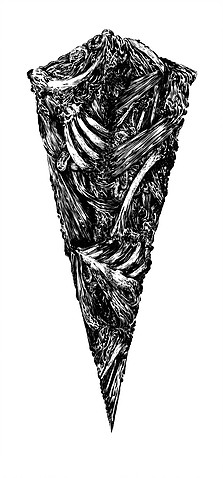
SCAN is pleased to announce the opening of ATAVIC MEMORY, a project curated by Sara Torres and Regina Pérez for the SCAN Project Room with works by Álvaro Albaladejo, Cristina Ramírez, Moreno & Grau, Alegría & Piñero and Fran Pérez Rus.
To look back at the original nature and the ideas, ways of life and materials of our ancestors leads to the emergence of an atavistic memory that takes us back to our historical predecessors and their way of understanding existence. Since the origins of art, artists have turned to nature, either to look for the supports and materials (earth, minerals, plants…) or because art has found in nature the most important source of inspiration for representation (ritual, sacred, symbolic, conceptual, among others).
In the different works of the artists participating in this exhibition –Álvaro Albaladejo, Cristina Ramírez, Moreno & Grau, Alegría & Piñero and Fran Pérez Rus– we observe how this archaic essence has become the thematic and spiritual centre. The pointy cusp of the “Aguja” (2018) by Álvaro Albaladejo from Granada crosses us with its multiple symbolic senses. On the one hand, it transports us to a natural landscape, perhaps of mountain peaks, and on the other, it reminds us of the primitive materials created by the first man. The technique of this sculpture, carbonized beech, speaks to us of the use of certain natural resources (wood or fire) with the aim of obtaining those primitive tools that sustained human survival. Fire is also the protagonist in the photographic work of Moreno and Grau, who go further, approaching the world of opposites in nature: the cave is a concave space, it is home; the mountain presents a convex profile, a landscape to explore. His work always finds in the natural environment the precise metaphors to talk about the concepts at odds, which are also the origin of the understanding of the universe for the human being (the feminine and the masculine, rain and fire, the Sun and the Moon). Cristina Ramírez‘s work also gravitates In these three pieces, Cristina explores the cycles of life and death and how they intertwine to generate an infinite circuit. The artistic team Alegría y Piñero, however, delves into the field of experimental sound. In this exhibition they present a fragment of their “Vocal Spectrum”, a set of 8 pieces made of wood, cane and virgin wax that, when blown, reproduce vowel sounds of a primitive nature. Although the sound emitted by these trumpets made of natural materials refers to the most basic components of human language, the vowel, its vibration makes it confuse with the roar of an animal. The gadgets designed by Alegría and Piñero are very elemental, perhaps that is why the sound they produce is also very elemental. All these symbols (fire, wood, the cave, the mountain, the first human grunts…) are an imprint that despite the passage of time is not diluted, because it is part of our origin as human beings, we could even say that this is projected into the future. This is shown in the work of by Fran Pérez Rus, who digitally recreates the image of a tree in flames. This piece, which is an evident ecologist proclamation, speaks to us of a dystopian futuristic panorama in which the only natural trick we have left are the different virtual recreations that the humans have carried out, a way of keeping alive that atavistic memory to which, despite the circumstances, we will continue united. .(Scan press-release)
SCAN. Spanish Contemporary Art Network. 13-19 Herald St. Bethnal Green, London E2 6JT
Image: Cristina Ramirez. Memoria Atávica. SCAN
